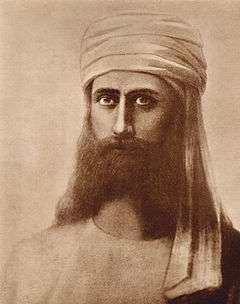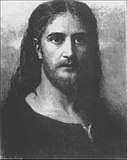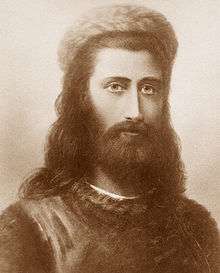Hermann Schmiechen
Hermann Schmiechen (22 July 1855 – c. 1923 or 1925) was a German portrait painter and Theosophist.
Hermann Schmiechen | |
|---|---|
| Born | 22 July 1855 |
| Died | c. 1923[1][2] or c. 1925[3] |
| Citizenship | Germany |
| Education | Kunstakademie Düsseldorf |
| Occupation | Painter[note 1] Theosophist |
| Spouse(s) | Antonia (Antonie) Gebhard[1] |
Biography
Hermann Schmiechen was born in Neumarkt, Prussian Silesia.[1] In 1872, he entered the Royal Academy of Arts and Crafts at Breslau, where he learned by Albrecht Bräuer (1830–1897).[5] In 1873, he shifted into Düsseldorf school of painting and became student of Karl Müller and Eduard von Gebhardt, and was also a member of the artists association Malkasten.[6] After studying at the Kunstakademie Düsseldorf, he learned in Paris at the Académie Julian.[7]
In 1883, on the recommendation of August Becker, Schmichen, almost simultaneously with Karl Rudolf Sohn, was invited into England to paint portraits of the British aristocracy.[8] From 1884 to 1895 he was a member of the Royal Academy of Arts.[9]
Theosophical portraits
June 20, 1884, a year after arriving in London, Schmiechen became a member the Theosophical Society. Then, fulfilling the request of Helena Blavatsky, he began to paint portraits of the Theosophical mahatmas. The portrait of the mahatma Koot Hoomi she assessed as "excellent" and immediately asked Schmiechen to begin working on a portrait of the mahatma Morya. It took him about three weeks,[note 2] to complete these paintings.[11][12][note 3][note 4]
A Russian writer Vsevolod Solovyov reported his impression of the portraits of the Theosophical mahatmas as follows:
"Subsequently, when I had thoroughly examined these portraits, I found in them much that was unsatisfactory from an artistic point of view; but their life-likeness was remarkable, and the eyes of the two mysterious strangers gazed straight at the spectator, their lips could almost have been said to move... Schmiechen had painted two beautiful young men. Mahatma Koot Hoomi, clad in a graceful sort of robe, trimmed with fur, had a tender, almost feminine face and gazed sweetly with a pair of charming light eyes. But as soon as one looked at 'the master' [of Blavatsky], Koot Hoomi, for all his tender beauty, was at once forgotten. The fiery black eyes of the tall Morya fixed themselves sternly and piercingly upon one, and it was impossible to tear oneself away from them."[15]
In 1901, Schmiechen, returning into Germany, settled in Berlin and joined the German section of the Theosophical Society.[16]
Paintings
- Bildnis einer Dame[note 5] (in German)
- Opernsängerin Lillian Nordica, 1878[18] (in German)
- Princess Victoria of Hesse[note 6]
- Princess Elizabeth of Hesse[note 7]
- Princess Mary Adelaide, Duchess of Teck, 1882[note 8]
- Princess Frederica of Hanover, Baroness von Pawel-Rammingen, 1884[note 9]
- Turtelndes Liebespaar am Fenster, 1895[9] (in German)
- Dame mit Rosenkorb, 1895[21] (in German)
See also
- Agni Yoga
- Theosophists as artists
- Theosophy (Blavatskian)
Notes
- "Painter. Portraits, local figures, genre scenes."[4]
- "From June 19 to July 9, 1884."[10]
- "There are various accounts of the production of the Schmiechen portraits, yet all agree that the works are the result of inspiration."[13]
- "Hermann Schmiechen... agreed to take part in a 'psychical experiment' to see if images could be transferred to his mind from those who had seen the Masters."[14]
- Ident.Nr. A II 450. "Das undatierte, höchstwahrscheinlich private Bildnis einer jungen Frau, rückseitig 'Irmgard' beschriftet, dürfte noch aus der Düsseldorfer Zeit stammen."[12]
- Royal Collection, Cat. No. 624.[19]
- Royal Collection, Cat. No. 625.[19]
- Royal Collection, Cat. No. 626.[20]
- Royal Collection, Cat. No. 627.[20]
References
- Genealogie.
- Neumarkt 1994, p. 176.
- Introvigne 2015, pp. 18, 34.
- Art Online.
- Introvigne 2015, p. 18.
- Malkasten.
- Neumarkt 1994, p. 176; Introvigne 2017, p. 212.
- Selke 2003, p. 16.
- Zeller.
- Hao Chin.
- French 2000, pp. 622–3.
- Freyberger.
- French 2000, p. 622.
- Sasson 2012.
- Solovyoff 1895, p. 78.
- Introvigne 2015, p. 33.
- French 2000, p. 609.
- Introvigne 2015, p. 18; Introvigne 2017, p. 212.
- Millar 1992, p. xxi.
- Millar 1992, p. 628.
- Introvigne 2015, p. 30.
Sources
- "Hermann Schmiechen". Oxford Art Online. Oxford University Press. 31 October 2011. Retrieved 2019-01-16.
- Schlesische Heimat: Stadt und Kreis Neumarkt (in German) (5th ed.). Der Verein. 1994. Retrieved 2019-01-16.
- "Hermann Schmiechen". Genealogie von Heidermanns (in German). 2016. Retrieved 2019-01-16.
- "Malkasten archiv". Künstlerverein Malkasten (in German). 2016. Retrieved 2019-01-16.
- French, B. J. (2000). The Theosophical Masters: An Investigation into the Conceptual Domains of H. P. Blavatsky and C. W. Leadbeater (PDF) (PhD thesis). Sydney: University of Sydney. Retrieved 2019-01-16.CS1 maint: ref=harv (link)

- Freyberger R. "Bildnis einer Dame". Nationalgalerie (in German). Berlin: Staatliche Museen zu Berlin. Retrieved 2019-01-16.
- Hao Chin V. (8 May 2012). "Schmiechen, Hermann". Theosopedia. Manila: Theosophical Publishing House. Retrieved 2019-01-16.
- Introvigne, M. (2015). Painting the Masters: The Mystery of Hermann Schmiechen (PDF). Torino: UPS. Retrieved 2019-01-16.CS1 maint: ref=harv (link)
- ———— (2017). "Painting the Masters in Britain: From Schmiechen to Scott". In Ferguson, C.; Radford, A. (eds.). The Occult Imagination in Britain: 1875–1947. Among the Victorians and Modernists. London: Routledge. pp. 206–26. ISBN 9781351168304. Retrieved 2019-01-16.CS1 maint: ref=harv (link)
- Millar, O. (1992). The Victorian Pictures in the Collection of Her Majesty the Queen. Cambridge University Press. ISBN 9780521265225. Retrieved 2019-01-16.CS1 maint: ref=harv (link)
- Sasson, D. (2012). "Koot Hoomi's portrait". In Albanese, C. L.; Stein, S. J. (eds.). Yearning for the New Age: Laura Holloway-Langford and Late Victorian Spirituality. Religion in North America. Bloomington: Indiana University Press. pp. 142–4. ISBN 9780253001771. Retrieved 2019-01-16.CS1 maint: ref=harv (link)
- Selke, R. (2003). "Erfolg und Ruhm am Hof einer Königin". In Bosbach, Franz (ed.). Ton Und Licht (PDF) (in German). Coburg. pp. 15–8. Archived from the original (PDF) on 2016-05-03. Retrieved 2019-01-16.CS1 maint: ref=harv (link)
- Solovyoff, V. S. (1895). A Modern Priestess of Isis (PDF). Translated by Leaf, Walter (Abridged ed.). London: Longmans, Green, and Co. Retrieved 2019-01-16.CS1 maint: ref=harv (link)
- Zeller M. (2014). "Turtelndes Liebespaar am Fenster". Katalog (in German). Lindau: Auktionshaus Michael Zeller. Retrieved 2019-01-16.
External links
| Wikimedia Commons has media related to Hermann Schmiechen. |


